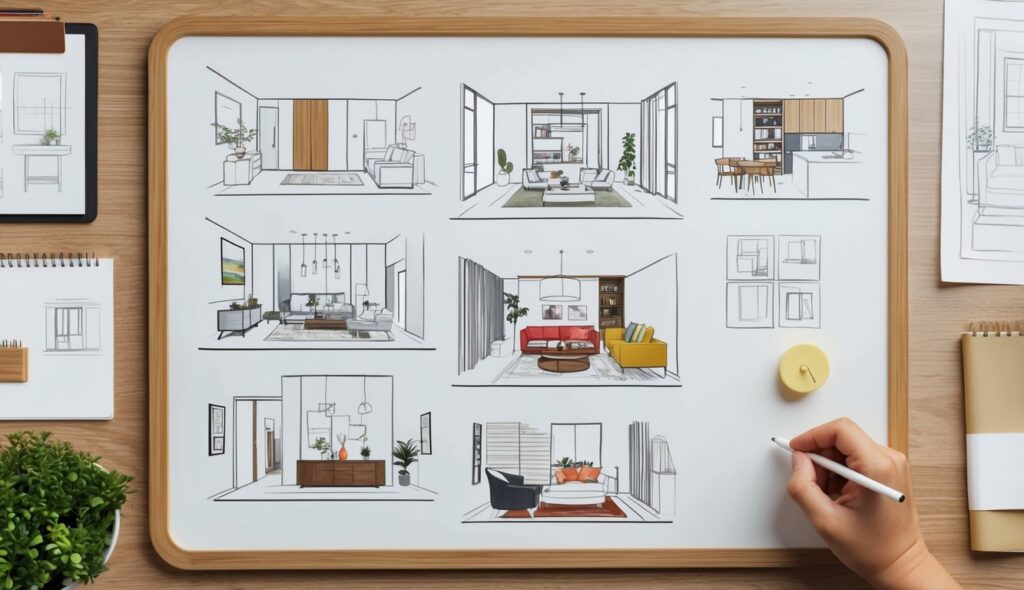Blinds have played a vital role in architecture, providing both functional and aesthetic benefits.
Remember to repin your favorite images!
Their historical use reflects innovation in privacy and light control.
Early blinds, such as wooden slats, were practical solutions for managing sunlight and ensuring interior privacy.
These elements have evolved over centuries, adapting to various architectural styles and regional needs.
By the mid-1700s, Venetian blinds became popular due to their versatility and design flexibility.
They allowed for precise control of natural light, making them a significant feature in residential and commercial buildings.
The choice of materials, from wood to metal, further enhanced their durability and stylistic appeal.
Modern-day architecture continues to integrate blinds as essential design components.
Today’s blinds come in various forms, from traditional wooden slats to more contemporary fabric designs.
These elements not only enhance the visual appeal of windows but also contribute to the building’s energy efficiency.
For more insight into how regional influences shape architectural design, explore the principles of regional architecture.
Evolution and Types
Blinds and shutters have transformed dramatically throughout history.
The evolution involves changes in materials, designs, and functionality, directly impacting architecture.
Variations include different types like Venetian blinds and roller blinds, with each style offering unique benefits.
Origins and Historical Development
The history of blinds can be traced back to ancient civilizations.
In Persia, blinds were initially developed to manage light and privacy. During the Middle Ages, various cultures started to adopt and adapt these window treatments.
By the 18th century, Edward Bevan patented the first Venetian blinds, which featured adjustable wooden slats.
These were soon incorporated into European and American homes, marking a pivotal moment in design.
The 19th century brought even more innovation, with various styles becoming prominent.
For instance, Roman blinds, inspired by earlier Roman architectural techniques, gained popularity for their practicality and aesthetic appeal.
Diversity of Materials
Throughout history, the materials used in blinds have varied greatly.
Originally, ancient blinds were made from available natural resources, such as wood and fabric.
Over time, technological advancements allowed the use of additional materials like metal and glass.
In the 20th century, the introduction of aluminum and synthetic fabrics revolutionized the industry.
Metal blinds offered durability and a modern look, while fabric blinds provided versatility in design.
Architects frequently integrated these materials into different window treatments, adding both functional and aesthetic value to buildings.
Types of Blinds and Shutters
Blinds and shutters come in various types, each serving distinct purposes.
Venetian blinds are popular for their adjustable slats, allowing for precise control over light and privacy.
Often made from wood or aluminum, they are suitable for both traditional and modern architectural styles.
Roller blinds offer simplicity and ease of use.
These blinds are made from fabric or synthetic materials and roll up neatly, making them ideal for minimalist designs.
Exterior shutters historically provided protection against weather and unwanted visitors.
Today, they serve both functional and decorative purposes, enhancing the architectural details of a building.
This adaptation to modern needs underscores the continuous evolution of window treatments in architectural design.
Functional and Aesthetic Role
Blinds play a crucial role in architectural design, offering both functional benefits and aesthetic enhancements.
They help regulate light and privacy, adapt to environmental conditions, and contribute to the visual appeal and acoustic characteristics of a space.
Light and Privacy Regulation
Blinds are essential for controlling light and ensuring privacy.
They manage the amount of sunlight entering a room, reducing glare and creating a comfortable environment.
Adjustable slats can be tilted to direct light where needed or block it out entirely.
This feature is particularly important in bedrooms and other private areas, allowing occupants to control visibility from outside.
Maintaining privacy while still letting in natural light is a key consideration for architects and builders.
Blinds can offer a solution that balances light penetration and seclusion, enhancing the functionality of window treatments.
The ability to easily adjust blinds adds a layer of control that fixed treatments cannot provide.
Climatic and Environmental Adaptation
Blinds also assist in adapting to various climatic conditions.
They help regulate indoor temperatures by blocking heat from direct sunlight, which can reduce the need for air conditioning.
During colder weather, closing blinds can provide an added layer of insulation, trapping heat inside and reducing heating costs.
For areas prone to heavy rain, blinds can offer some protection to windows from water damage.
They also help manage ventilation by allowing air to flow through adjustable slats while keeping out direct sunlight or rain.
This feature is particularly useful in regions with variable weather patterns.
Architectural Beauty and Texture
Blinds contribute significantly to the aesthetic value of a building.
Available in various materials such as wood, metal, or fabric, they can complement other architectural elements and interior decor.
The color and texture of blinds can enhance a room’s design, adding visual interest and coherence.
Architects often use blinds to add layers of depth and texture to a space, making it more visually appealing.
The choice of louver style and material can transform the appearance of a room, making it feel more modern, classic, or cozy, depending on the design goals.
Spatial Sound and Acoustics
Blinds can influence the acoustics of a space. By absorbing sound, they reduce echo and improve sound quality within a room.
This is especially important in spaces where sound clarity is crucial, such as offices, conference rooms, and home theaters.
The material and design of the blinds will determine their effectiveness in sound absorption.
In large, open spaces, blinds can help create separate zones with better acoustic properties. They can also be used alongside other elements like curtain rings and lace curtains to enhance both sound management and aesthetic appeal.
The careful selection of blinds can thus play a dual role in enhancing both functionality and beauty in architectural design.

